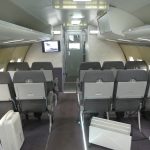Technical Data
Length: 93ft 6in / 28.50m
Height: 24ft 6in / 7.47m
Wing Span: 88ft 6in / 26.97m
Service Ceiling: 37,000ft / 11,285m
Max Speed: 410mph / 660kmh
Max Weight: 98,500lbs / 44,678kgs
Seating Capacity: 79
Engines: 2 x Rolls Royce Spey Mk 512
Our Aircraft
BAC One-Eleven series 479 (cn 250) ZE432 was originally built at Bournemouth in 1973 as DQ-FBV for Air Pacific of Fiji and used on their inter island services. It was taken out of airline service in March 1984, sold to the UK’s MoD and delivered to the Empire Test Pilots School at Boscombe Down in February 1985. It was mainly used as a flying classroom for training test pilots from around the world. It made its last flight on 27 November 2009 and was officially withdrawn from service in January 2011 due to corrosion. It was dismantled at Boscombe Down and the foreword fuselage section moved to the Bournemouth Aviation Museum in April 2014. It is fitting that the Museum should have a BAC One-Eleven airliner on display as Bournemouth Airport was the home of the British Aircraft Corporation factory which designed and built the airliner during the 1960/70’s.
Type History
The One-Eleven origins go back to the Hunting Aircraft H.107 1950’s design which was planned to carry 48/56 passengers. In 1960 with the mergers of several UK manufacturers the aircraft became part of the British Aircraft Corporation and named the BAC.107. It was subsequently enlarged to 79 seats designed as a short range ‘Bus Stop’ airliner with two 10,400 lb thrust Rolls-Royce Speys and renamed as the BAC One-Eleven. It was to be the successor to the Vickers Viscount of the 1950s.
Production was undertaken at Bournemouth, where the prototype first flight was on 12th August 1963, The Series 200 aircraft came quickly after with orders from British United, Aer Lingus, Braniff Airlines and British Eagle. This was then followed by the more powerful Series 400 for American Airlines. Sales to the United States were to be big dollar earners and for many years, the One-Eleven was the largest ever export earning airliner for Great Britain. At home One-Elevens were frequently used for package holiday flights to the Mediterranean and by the late 1960s they were regularly seen in service from Bournemouth Airport, starting with Palmair flights in the spring of 1965.
A stretched 99 seat Series 500 was developed for BEA who ordered eighteen in January 1967, followed by others for British United, Caledonian and Court Line. As with the earlier versions, many were used for holiday flights – those of Court Line being particularly well known for their bright colour schemes. Total One-Eleven production amounted to 235 aircraft, including a few produced in Romania.
By the late 1980s many of the original airlines had sold their aircraft to other operators such as Dan-Air or European. The USA and Saudi Arabia were to be the home of many VIP versions. By 2000 European Aviation was to be the only major operator in Europe, with its fleet based at Bournemouth in the same hangars in which they had been built 35 years earlier. However, the One-Eleven had to be taken out of airline service in the spring of 2002 as it was unable to meet new noise regulations. It’s Spey engines had always been noisy and no suitable replacement had been developed.
The final UK commercial operation of the One-Eleven took place on 3Ist March 2002. European Aviation’s Srs500 G-AZMF operated the final ‘UK One-Eleven fare paying flights with three special farewell charters from Bournemouth. By 2016 the two remaining airworthy One-Elevens were both to be found in the USA, as test-beds for military manufacturer Northrop Grumman. They retired their last BAC One-Eleven testbed N164W as well as the last flying example of a BAC 1-11 in the world on 6th May 2019.


